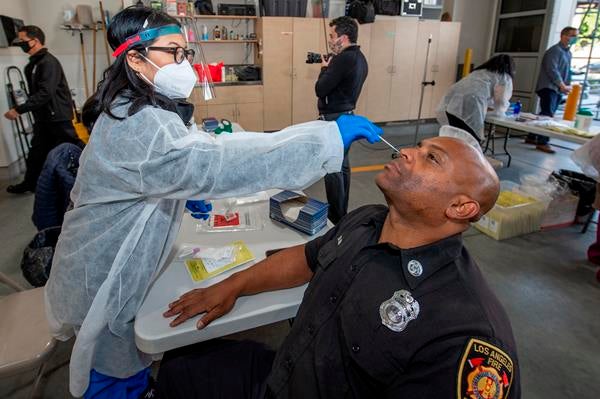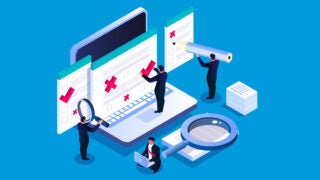Contact: Gary Polakovic (323) 527-7770 or polakovi@usc.edu
Beyond pandemic: one year since the coronavirus crisis
One year since the worst disease outbreak in a century, the coronavirus crisis has ravaged health, economies and governments. More than 115 million people have been infected and 2.6 million have died — including about 515,000 in the United States. The pandemic exposed the frailty of the global economy, inequities in healthcare and fault lines in American society. Yet, pandemic also unleashed a scientific juggernaut that produced vaccines in record time, workplace transformations affecting families, and winners and losers in business. Ripple effects will be felt for years, as examined by USC experts quoted here.
Health and science
USC researchers helped save lives, spur advances against diseases
Maja Mataric, interim vice provost of the USC Office of Research, distinguished professor of computer science, neuroscience and pediatrics and the co-director of USC Robotics Research Lab.
Contact: vpres@usc.edu or uscnews@usc.edu
“COVID-19 has drawn researchers together in unprecedented ways. The pandemic has proven that researchers both at USC and worldwide can quickly mobilize against a common threat,” Mataric said. “New collaborations were formed. For its part, the USC Office of Research dedicated $1.7 million to the effort in 2020, and set up a large set of web resources for researchers, including ways to showcase pandemic-related research, connect researchers within USC, facilitate idea exchanges via a Slack channel, and many virtual workshops through the USC Center for Excellence in Research. Undoubtedly, the research networks forged both at USC and worldwide during the pandemic will continue and lead to other critical discoveries that can save lives.”
The global coronavirus response was uneven
Andrew Lakoff is an associate professor at the USC Dornsife College of Letters, Arts and Sciences and the USC Annenberg School for Communication and Journalism.
Contact: lakoff@usc.edu
“We’ve had to learn about the disease on the fly and figure out what works to mitigate it as quickly as possible,” Lakoff said. “To do that we really depend on governments being competent, coordinated and capable of rapid and intensive intervention. As we’re seeing, that’s only true in certain parts of the world.”
COVID-19 exposed flaws in U.S. health system that need fixing
Neeraj Sood is an expert on health policy and the government’s response to the COVID-19 pandemic. He is a researcher at the USC Schaeffer Center for Health Policy and Economics and the vice dean of research for the USC Price School for Public Policy.
Contact: nsood@usc.edu
“Our government hasn’t adapted to the urgency of the problem and sometimes perfect has been the enemy of the good,” Sood said. “For example, the World Health Organization gave the specifications for COVID-19 testing and many countries adopted them and started testing early. The U.S. CDC instead sought to come up with its own COVID test, then bungled the development of the test, delaying testing and causing countless deaths. We need to reimagine and rebuild our public health infrastructure so we can promptly respond to emerging threats.”
Photo caption: Jennifer Nava, RN, administers a nasopharyngeal swab COVID-19 test on Los Angeles City Fire Captan Leon Dunn during a L.A. County Department of Public Health rapid antigen study led by USC Schaeffer Center and Price School of Public Policy last year.
Photo credit: USC Photo/Gus Ruelas
Business and economy

TV, film may be changed forever
Gene Del Vecchio is an adjunct professor of marketing, TV and film industry at USC Marshall School of Business.
Contact: edelvecc@marshall.usc.edu
“The new business model is how to gain and retain streaming subscribers, thus to optimize the long-term relationship. Database analysis will become extremely important in order to understand subscriber preferences and to deliver customized content and marketing. Despite the upheaval, there has never been a better time to be in entertainment, in general, and in production,” Del Vecchio said.
Government incentives helped, but need better focus
Adam Rose is the director of the USC Center for Risk and Economic Analysis of Terrorism Events and an expert on projecting the economic impact of disasters.
Contact: adam.rose@usc.edu
“Various government tax and fiscal policies that aim to strengthen consumer confidence and boost consumer spending will further accelerate the economy’s recovery from the pandemic,” Rose said. “However, not all fiscal stimulus programs have been successful. Businesses are not taking loans, and a large proportion of cash payments are being saved. One implication for policymakers is that they target the sectors most directly affected by the shutdowns and those that are still recovering such as dining, travel, and entertainment.”
Photo credit: Pixabay
Workforce

New policies needed to bolster working moms and their families
Jennifer Hook is an associate professor of sociology at the USC Dornsife College.
Contact: hook@usc.edu
“Mothers are disproportionately pushed out of the labor force by closures of schools and childcare centers,” Hook said. “COVID-19 has also highlighted the extreme economic insecurity so many families were experiencing long before the pandemic. National and state governments must make greater investments in policies that support working mothers and their families, including access to affordable childcare, paid family leave, and robust unemployment insurance.”
COVID-19 exacted a heavy toll on most vulnerable workers and students
Juan De Lara is an associate professor of American studies and ethnicity at the USC Dornsife College.
Contact: jdelara@usc.edu
“COVID-19 victims include a large group of essential workers, including those in food services and the logistics industry, who were already living under precarious economic conditions,” De Lara said. “In California, the pandemic has compounded inequalities for Latinx and Black students in under-resourced public schools. The disease inflicted disproportionate harm that helped stoke social justice movements last year and underscore the need for remedies in 2021.”
Photo credit: iStock
Social justice
 COVID-19 helped fuel the Black Lives Matter movement
COVID-19 helped fuel the Black Lives Matter movement
Reginald Tucker-Seeley is an assistant professor of gerontology at the Leonard Davis School of Gerontology
Contact: tuckerse@usc.edu
“The deaths of George Floyd and Breanna Taylor by police last year brought increased attention to systemic racism in the United States and to the Black Lives Matter movement,” Tucker-Seeley said. “The disproportionate impacts of COVID-19 on racial minorities sharpened focus on how systemic racism creates bad outcomes, especially for Black people, from interactions with police, employment, education and the healthcare system.”
2021: A year for healing and transformation post-pandemic
Manuel Pastor is a professor of sociology and American studies and ethnicity at the USC Dornsife College.
Contact: mpastor@dornsife.usc.edu
“COVID-19 reveals our illness as a society: employment precarity, racial wealth gaps, lack of legal status and uneven access to health care,” Pastor said. “The hope is that the Biden administration understands COVID-19 and makes health equity central to pandemic response. Last year was dealing with a health crisis and reckoning with racism; 2021 could be a year of healing but also of truth and transformation.”




